
More Information on the Amur Leopard at Wikipedia
Conservation Information on the Amur Leopard at The Amur Leopard and Tiger Alliance Website
Abstract
The critically endangered Amur Leopard's habitat in Primorsky Krai, Russia, is being destroyed by fires. Frequent ground fires are converting the leopard's preferred habitat, dense forest, into grasslands. This study employs a comparison of Landsat images using NDVI analysis, fire data from FIRMS, SRTM data, and night light data to examine fire extent and forest loss. The images clearly show that deforestation is occurring in the area, and the fires and loss of greenness are concentrated near human settlements. This reinforces the theory that locals may be causing or encouraging fires either deliberately or indirectly by converting forests into more easily burned hayfields. Educating the locals on the importance of wildlife conservation, as well as creating fire breaks to slow the spread of fires in leopard habitat, should help conservation efforts.
Introduction
In far-eastern Russia, along the Pacific coast, is a biodiversity hotspot called Primorsky Krai (spelling variations include Primorskii, Primorskiy, and Primorye Kray). This area is home to the critically endangered Panthera pardus orientalis, also known as the Amur Leopard or Far Eastern Leopard. No more than thirty of the cats currently survive in the wild, and the small population urgently needs protection. One of the main threats to the survival of these cats, along with poaching and human development, is the destruction of their habitat by fires. Amur Leopards require dense forest habitat, but frequent fires turn the forests into grasslands. Locals are thought to encourage burning because ferns that are valuable as a cooking ingredient prosper in the open grassland environment. The most prominent research on this phenomenon was undertaken by ALTA (The Amur Leopard and Tiger Alliance). ALTA’s paper examines the extent of fires in Primorsky Krai, and finds a correlation between high fire occurrence and areas of human activity. To build upon ALTA’s research, additional analyses of satellite images were conducted. The intent is to determine the extent to which the fires have damaged the landscape, and the loss of tree-cover in the Primorsky Krai area.
Methods
The study area is the southwestern tip of the Primorsky Krai region of Russia, along the border with North Korea and China. This coastal region spans from about 44°N, 130°E to 42°N, 132°E. The diverse flora of the region includes tundra, coniferous-deciduous forest, and forest-steppe or grassland. While some of the oak trees are able to withstand small fires, the fires in the area have become too frequent for even the most resilient trees to survive. To examine the conversion of forest to grassland in Southwestern Primorsky Krai, several data sets are used. A time-series obtained from the FIRMS Web Fire Mapper shows all of the fires that have burned in the area from 2000 to 2010. Landsat images from 1976 and 2007 were processed by applying an NDVI to red-IR coded images, and a density slice was applied to show the results in color. SRTM elevation data were downloaded from the GLCF and can be used to evaluate the terrain. A 3D model of elevation in the area shows the shape of the coast-line. Comparisons over time are made to determine the extent of loss of forest cover.
The study area of the Landsat images and SRTM data:
View Primorsky Krai in a larger map
Results
Overall, it appears that there are a large number of forest fires in the area, and closed forest is transitioning into open grassland, which is unsuitable habitat for the Amur Leopard. Analysis of the NDVI's of the Landsat images shows that greenness (photosynthetic activity) has decreased in various areas within the study site. The areas where greenness has decreased correlate with lighter areas in the night-light image, indicating that deforestation is taking place mostly near human settlements (near the coast). Comparison with the FIRMS fire data also shows that the areas that show a loss of greenness tend to be more frequently burned than other areas. These findings are particularly disturbing when it is considered that most of the Landsat study area is within the Barsovyi Wildlife Refuge. Although the fires may not be large and destructive, their frequency prevents the forest understory from regrowing, leading to a gradual transition to grassland as the trees die out.
Imagery
The following images are of the South-western tip of the Primorsky Krai region of Russia, where the few remaining Amur Leopards reside. Click the images for a larger view. The first map shows the Amur Leopard's historic distribution (pink) and the area it is currently restricted to (red). The area covered in subsequent images is within the red section of this image:
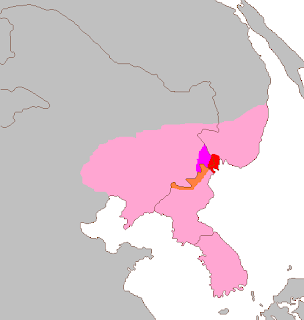
Source: Wikipedia
A subset of a 1976 Landsat image of the area:
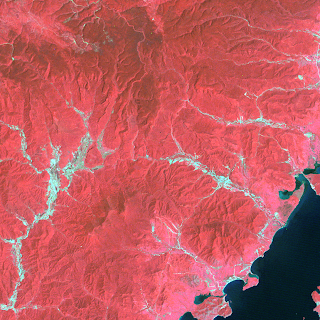
A subset of a 2007 Landsat image of the area:
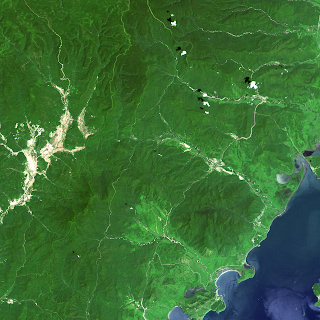
An NDVI of the 1976 Landsat image:
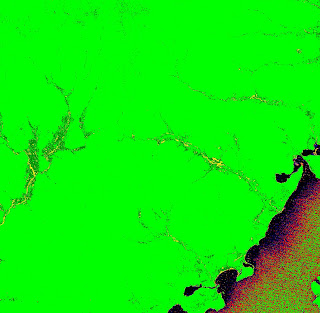
An NDVI of the 2007 Landsat image:
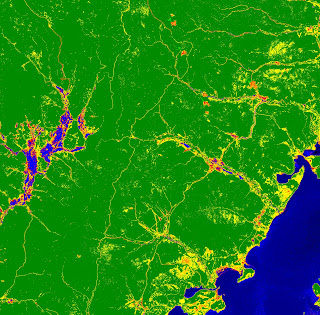
Colors, from highest to lowest NDVI Values (applies to both NDVI images)
Light green: highest NDVI value
Dark Green
Yellow
Orange
Red
Light Blue
Dark Blue: lowest NDVI value
The 2007 Landsat NDVI again. The circled areas are areas that appear significantly different from the 1976 image, and indicate possible burn scars, areas of deforestation, or areas where human settlement or agriculture has been expanded:
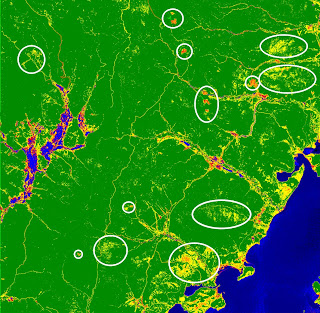
SRTM 90 meter resolution elevation image for the area:
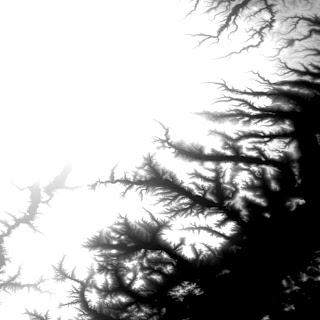
A 3D Surface View of the SRTM 90 meter elevation image. A notable crevasse is visible in the western portion of the image, which shows up as a low-vegetation area in the Landsat images:
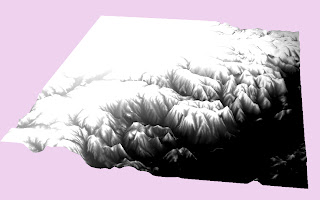
Night Light Image of the area, which roughly indicates where human settlements are:
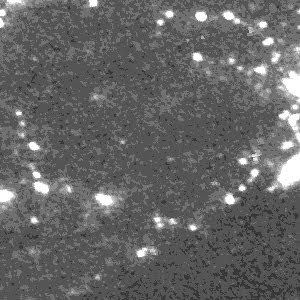
A slideshow of fires in the area from 2001 to 2010, from the FIRMS Web Fire Mapper. Protected areas are marked in green, and orange squares mark where fires occurred. These images cover a larger area than the Landsat and SRTM.
Discussion
These findings reinforce those of ALTA's research in the area. ALTA found that areas already affected by human activity (meadows and hayfields) were much more likely to burn than other areas. This correlation between areas of human activity and higher frequency burning is clearly visible in the FIRMS slideshow.
There are limitations to this research. For example, the 1976 Landsat image is much lower quality than the 2007 image, which made them difficult to compare. There were also a few clouds in the 2007 image which can affect the analysis.
Additional research in this area is needed. Although greenness is a good measure of vegetation cover, higher resolution imagery could be analyzed to clearly distinguish forested areas from open grasslands. Analysis of forest cover could definitively show where deforestation and leopard habitat loss has occurred. ALTA also mentions that the border patrol in the area has acted as an effective fire break which stopped fires from spreading across the border zone. Part of their efforts involve creating more fire breaks to slow the spread of fires within leopard habitat. Additional research could further document the efficacy of such fire breaks, and perhaps encourage funding for their projects. ALTA is also pursuing programs to educate locals on the importance of conserving the Amur Leopard, and promoting ex-situ conservation of the species.
References
Miquelle, D. G., Murzin, A., Hötte, M. "An Analysis of Fires and Their Impact on Leopards in Southwest Primorye". TIGRIS Foundation and Wildlife Conservation Society. 2004. http://amur-leopard.org/files/document%20page/A.%20leopard%20range%20fire%20analysis%202004%20%283%20mb%29.pdf.
Pikunov, D. G., Aramilev, V. V., Fomenko, V. V., Miquelle, D. V., Abramov, V. K., Korkishko, V. G. and Nikolaev, I. G. (2000) Endangered species: The decline of the Amur leopard in the Russian Far East. Russian Conservation News 24: 19.
Uphyrkina, O. & O’Brien, S.J. (2003) Applying molecular genetic tools to the conservation and action plan for the critically endangered Far Eastern leopard (Panthera pardus orientalis). Comptes Rendus Biologies 326 (Supplement 1): 93-97.
Uphyrkina, O., Miquelle, D., Quigley, H., Driscoll, C. & O’Brien, S.J. (2002) Conservation Genetics of the Far Eastern Leopard (Panthera pardus orientalis). The Journal of Heredity 93 (5): 303-311.